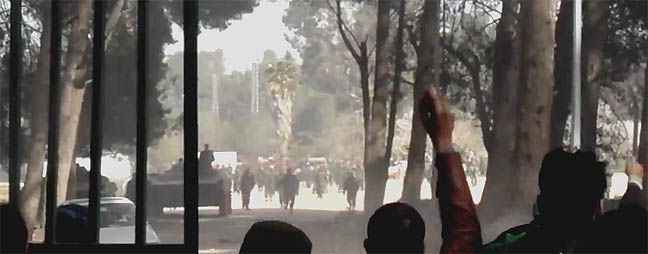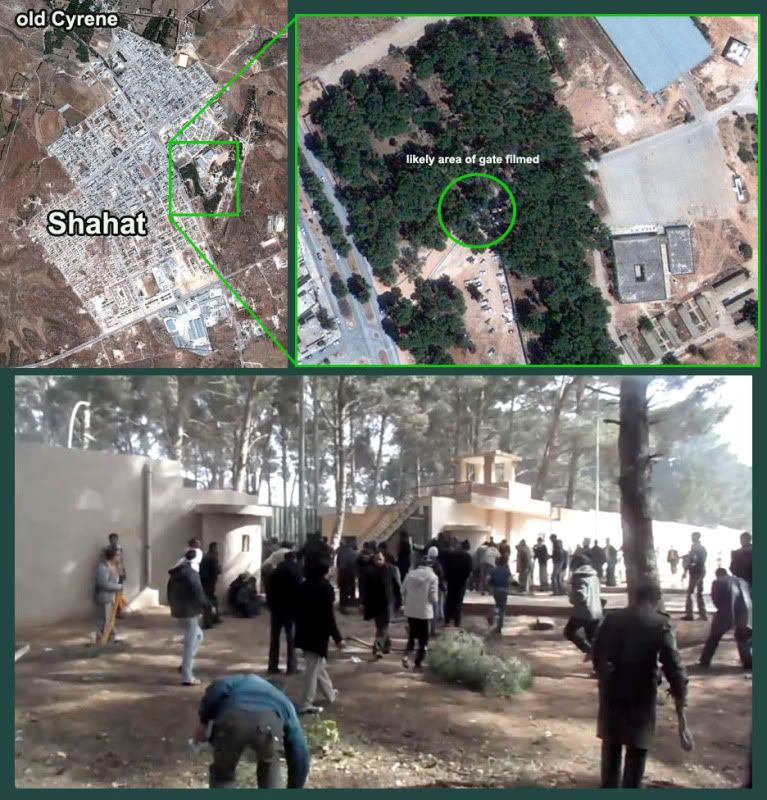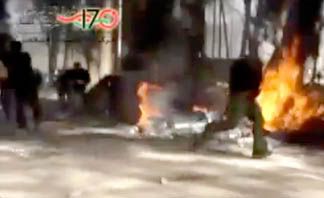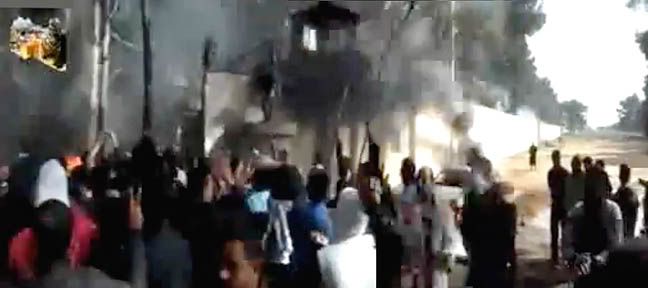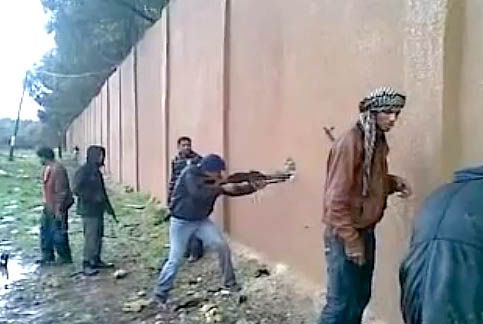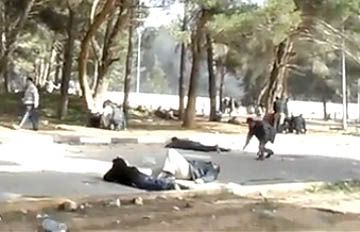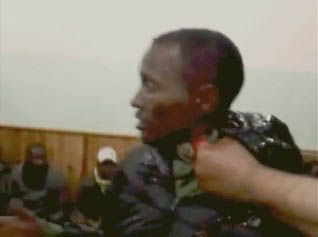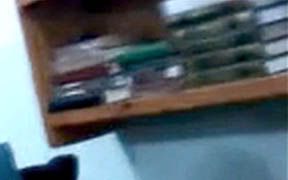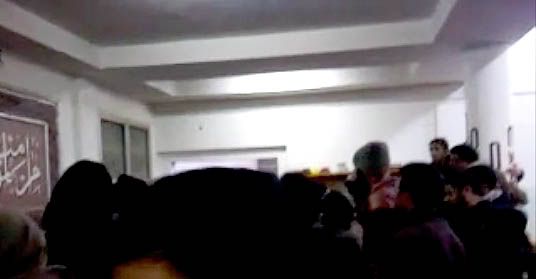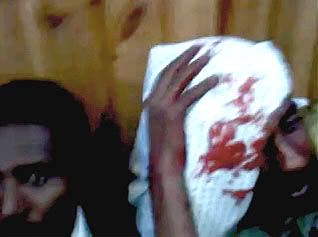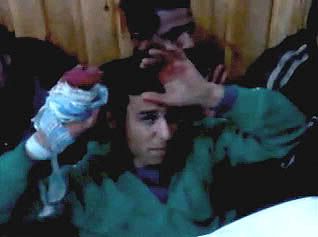last update November 12
We start with two videos collected at this page of the "Libyan War" blog/site, as showing "peaceful protesters open fire at direction of army compound in Benghazi." The actions described seem accurate. One video (below, posted Feb 22) shows an ambulance leaving a compound, followed by what I believe is an internal security paddy wagon. (Update Nov.11: Reader Felix says "The black "padded wagon" in video 1 is certainly no internal security van,as it is labelled in arabic (of course!) Inna Lillahi Wa inna ilayhi raji'oon : To Allah we belong and to him we return - إِنَّا لِلّهِ وَإِنَّـا إِلَيْهِ رَاجِعونَ." This sounds kind of like a "hearse," indicating someone has died.)
They drive at medium speed down a dusty road amid a scattered crowd of apparent protesters, and dense gunfire they're not running from. Its youtube posting idiotically entitles the thing "Libya : Random Shootout Towards Ambulances and Protestors." Looks like the shooting is coming from the civilians, and only might have been towards the ambulance. More likely they're firing in the air, in celebration for the injuries it seems were inflicted on someone else prior to this point.
The next video shown, posted by the same user (LAKOMTUBE) on the previous day (Feb 21), supports those calls. This time, we're seeing "Live Fire between People and Gaddafi Regime." It shows a smaller and denser group of "protesters" hiding from lines of fire inside, while at least one aimed an assault rifle in and fired repeatedly, trying to "express himself." Something they got inside has also started a few of the trees on fire, starting the smoke chaos "non-violent insurgencies" seem to love. (the real smoke, we'll see below)
There was another video once shown at that Libyan War post, called "Protestors gather around a compound," but it has since been removed by the user. But in R. Breki Goheda's half-hour documentary video (part 1 embedded below) is a scene, perhaps the same as the one lost, of what I've decided is clearrly the same site. Shown at 5:40 (by luck with the scene in question chosen as the thumbnail), this is given as a military barrack besieged by hostile and, as we've seen, slightly armed criminals.
The narrator says of the response to thie civilian onslaught:
This video demonstrates that soldiers refused to open fire at protesters. Rather, they retreat into the center of the barrack, and open fire into the air as the attackers were advancing in the barrack.Indeed, inside we see clustered soldiers and vehicles in the mid-distance. They seem to be armed but only at the ready. He says further the insurgents were later "able to storm" the place, among a list of three places (see below), between them seizing a fair amount of weapons.
Update, Nov. 5: More Views and a Location
The location of this incident, for one thing, vexed me for quite a while. Then recently while skimming videos from al Baida, in a playlist made by molibya, I saw the same scene explored here, in a slightly different video. Was this base in or around al Baida? The title doesn't help:
مشاهد حية للإشتبكات في ليبيا [trans: Vivid scenes of clashes in Libya]
http://www.youtube.com/watch?v=Mts_qRO4nLs
Uploaded by brqnetwork on Feb 21, 2011
It's apparently the same video from above with the one rifleman firing into the gate. It's lower resolution, but has some extra footage at the beginning that to me shows something interesting. A military hostage, perhaps, against the wall just on the right side of the gate. In an olive green shirt, fair skin and dark hair, he's facing the opposite way of most others. At first glance, he seems to be being frisked or manhandled somehow by another guy. Then he's briefly seen looking to the side, and putting his hands out submissively.
Then down the list I saw a video that made me jump - a very high-res version of the video I had to cite Goheda's video for above (saved a copy).
Uploaded by hamd95 on Mar 1, 2011, and no further date given.
This helped me see more clearly the interior of the base and forces within, and everything else. I don't see much armed activity here, I have to say. People are bending over to pick up rocks, or throwing them. Some fiddle with other devices, perhaps (guy in trench coat, lower right in the image at the very bottom, for one)... many clues are available here.
The title of this posting is what help narrow down a location: اول كتيبه تسقط فى ليبيا من نظام القذافى ( مدينة شحات) [trans: Down with the first battalion in Libya of Qaddafi's regime (the city of Cyrene)]. I looked up Cyrene, and it's a modern small town as well as archaeological site (and clearly the origin of the whole region's name-Cyrenaica). It's on the northern outskirts of Shahet, just east of al Baida.
The army base at Shahet fell to rebel forces on February 19, I have heard, two days after the Day of Rage. The video location is not at Cyrene, but on Shahat's eastern flank. There I found an expansive walled compound, where an angled road passes a gate, in a heavily-treed area. Matching the video, this area has dense trees on both sides of the wall, making the gate area invisible from above, but with the right-hand-side (when facing in) more open.
Base and takeover details from reader Felix, as submitted in a comment, trumps my sloppy old guesswork:
The military barracks which the commentator around 6.00 in the causes and facts video 1/2 says "Attackers were able to storm Hussein al-Juweifi and Shahat Military Barrack..." Anmesty International, in their May 2011 report actually mentions Hussein al-Juweifi military barracks in Shahat (are they the same, or are there two barracks in Shatat?): In al-Bayda, a resident told Amnesty International that on 18 February, as soldiers inside the Hussein al-Juweifi military barracks in Shahat, east of al-Bayda, were beginning to lose control after protracted battles with protesters, he attempted to mediate to avoid more bloodshed:It seems to all be the same place, now with a location and a name and, as we'll see, tons of more video views spanning, perhaps, nearly two weeks. But the soldiers were surrendering on the 18th. Why it was later torn down isn't clear.
“I asked to speak to a senior officer at the compound whom I knew from before… I gave him my word and said: if your soldiers surrender, they will be safe. As the group of soldiers were coming out to surrender, the protesters were very angry and shot dead two soldiers… they were Libyans, not foreign mercenaries… I feel guilty because was it not for me, they may not have come out.”The barracks were at one time commanded according to this document by Colonel Al-Jarih Farkash. Several nephews of Gaddafi were Captains at the base..Abdul Qadir Saeed and Abdul Rahman Abdul-rahim al-atrash. The battalion was at Al Beida.(1993 data) (Libya's Qaddafi by Mansour O El-Kikhia, University Press of Florida, USA) [...] The barracks are also called Al-Jarah barracks, even though the arabic title says Medina Shahat - Katiba Al Juweifi in this video, Al Jarah Barracks battle (not really). A non-faked video shows it being demolished in May 2011.
After The Battle...
So... this is some part of the Shehat campaign, somewhere around the 20th. Earlier in the same Molibya playlist were mentions of a battle of Cyrene. One of them:
"20110218149"
http://www.youtube.com/watch?v=R146AFzeJkc
Uploaded by coffeeaddict99 on Feb 19, 2011.
The title suggests a date of the 18th, Petri Krohn tells me Mediainfo gives its record time as UTC 2011-02-18 14:50:33. The description says, Google translated from Arabic:
This is the return of the al Baida youth after their return from the battle of Cyrene, which Lapid [??], the remainder of the brigade a battalion called the enhanced 32 Thurs [??} [??]Felix suggests this may mean 32th, or 32nd, and may thus refer top the infamous and ubiquitous Khamis brigade, "otherwise known as the 32nd reinforced Khamis Gaddafi battalion, as noted in this Al-Jazeera interview with General Fatah Younis, Gaddafi's friend turns foe , uploaded early on 1 March 2011." Here on whichever day and after defeating whoever, we see "protesters" in general control of at least part of al Baida, returning from a raid with weapons. We see face-covered militants, machine guns, boxes carried. Rockets for RPGs are held aloft in one passing truck bed to fervent cheers, then tank shells, larger rockets, and strings of heavy bullets. Only a few rifles are fired into the air in celebration, however.
And here's another Coffeeaddict99 video from the 19th:
http://www.youtube.com/watch?v=Jz2ZkHP1s-I
The title, translated by Google: "Young white [al Baida] city Mtugeon [??] to attack the camp of Cyrene This is one of a group of 106 anti-defender." We see a big barrel artillery piece in the bed of a pickup truck, surrounded by wowed, victorious, knife-wielding young militants. There are no military defectors to be seen in any of this.
All Shahet "Battle" Videos: Feb 16-18
Starting from invaluable comments below, especially from reader Felix, I'll use this space to organize the videos covered above and others, in the hope of establishing what happened and when in Shahet. Reader Petri Krohn has tipped me off to software that will (usually) show the date and time a video was recorded (if it's raw and converted from Youtube, not a FLV downloaded with Safari). This will be called on when relevant below.
The earliest - and often most fascinating - glimpses I've seen are compiled in this video:
The earliest - and often most fascinating - glimpses I've seen are compiled in this video:
Sahat [sic] intifada story
Source: ORWA31
duration 9:34. Credited on-screen as: "Cyrenaica for International Production."
Covering only a three-day span, this compilation suggests an "Initifada"of Feb. 16-18. It starts with video from the night of Wednesday the 16th. We see a peaceful march with chanting, but also a bonfire just outside some walled compound, with no one running from live fire, and another building roaring with flames inside it.
Nothing is shown in this video for the 17th, which is strange. That was exactly the called-for "Day of Rage," where other cities were provoking state violence and reaping the PR windfalls on video. But along with much of what happened in other towns, Shahet's total activity shared on video seems to be zero.
Footage resumes on the afternoon of the 18th, from the angle of sunlight and deducing from the presence of "18" and no other numbers appaearing amongst the Arabic text I cannot read. It shows no clear fighting but sudden control achieved by angry, unarmed civilians. A walled compound has fallen, or at least its walls are vulnerable. A dump truck is backed into it, knocking a hole. To the left are two more rough portals through the wall, one smoke-stained. How many do they need before they can finally get in?
Footage resumes on the afternoon of the 18th, from the angle of sunlight and deducing from the presence of "18" and no other numbers appaearing amongst the Arabic text I cannot read. It shows no clear fighting but sudden control achieved by angry, unarmed civilians. A walled compound has fallen, or at least its walls are vulnerable. A dump truck is backed into it, knocking a hole. To the left are two more rough portals through the wall, one smoke-stained. How many do they need before they can finally get in?
The following edit makes it seem this is the same wall (and it apparently is) as the compound then shown, the same al Jarah barracks examined here. It's late afternoon, the gates are open, and people are walking in like they would to the zoo. There's some sort of white car to the right of the gate, which I thought seemed burnt. Atop the wall is the guard station, never shown manned, looking to like it was burned and soot-covered as well. Another video below confirms both hunches.
Here's another Youtube video claiming to be "Fighting in the city of Cyrene the first day of the Libyan revolution." It was only uploaded in late April, and mediainfo says April 28 - the date it was stamped in a program I presume. So we cannot say a certain date, but it seems a best fit with early afternoon of the 18th. The white car is seen at the beginning, trashed and tireless if not burnt. It's very shaky, bad camera work, filmed at the gate, panned in too close to give much detail. People are seen both walking in triumphantly, clapping, and also running out, at gunfire as if under attack within the base. Then they feel safe and keep going... There must be hundreds of "protesters" inside by now, burning a truck and piles of junk near the gate. No guns are seen, just clubs and sticks and a whole limb from a tree, held by people continuously running back out (like the masked militant at left). Then an ambulance and a black van drive out, in a clearly different scene from the one we opened with.
Here's another Youtube video claiming to be "Fighting in the city of Cyrene the first day of the Libyan revolution." It was only uploaded in late April, and mediainfo says April 28 - the date it was stamped in a program I presume. So we cannot say a certain date, but it seems a best fit with early afternoon of the 18th. The white car is seen at the beginning, trashed and tireless if not burnt. It's very shaky, bad camera work, filmed at the gate, panned in too close to give much detail. People are seen both walking in triumphantly, clapping, and also running out, at gunfire as if under attack within the base. Then they feel safe and keep going... There must be hundreds of "protesters" inside by now, burning a truck and piles of junk near the gate. No guns are seen, just clubs and sticks and a whole limb from a tree, held by people continuously running back out (like the masked militant at left). Then an ambulance and a black van drive out, in a clearly different scene from the one we opened with.
Back to the "Sahat intifada" video from ORWA31. The trashed interior is also shown after another cut, presumably some other time on the 18th. Within the expansive lot, rebel types mill about, loot, burn, and film freely. There are trees and green fringes, but it's smoke-filled, junk-strewn and spotted with wildly burning vehicles and buildings. Clearly, this was among the earliest of military mass defection to the side of the people, but none of the defectors are shown (except one, high-ranking, and dead - see below).
Then there's a view walking down the street outside the base (2:57). Two trucks, their occupants elsewhere now, are seen burning fiercely, as smoke pours from the open gateway of the base itself. Along the way, a rebel flag is seen, chanting about Allah, a man with a hatchet, and just immense amounts of smoke.
Then we see an injured loyalist, it seems, carried out and into a mob that surrounds him. Two middle-aged men finally escort him through, forcing past the hot-heads. Then a bus with a rebel flag, at 5:40 military trucks full of people with machine guns are seen driving by at great speed. Other trucks are shown being filled with as many fighters as possible, and speeding off. A single artillery piece, several masked men, a cheering crowd, and light-hearted dancing with bullets are also seen in the video as it closes its coverage of the 18th. Fascinating work.
Another, more amazing video from ORWA31 shows some events that seem to fit with this day.
إقتحام كتيبة حسين الجويفي بمدينة شحات . [Break into the battalion Hussein Jawafa city of Cyrene]
http://www.youtube.com/watch?v=3nPg1YThjdo
Duration 10:09
This densely-packed video compilation starts with a night-time scene, perhaps the 16th or 17th, in front of the main gates. Men are waving knives and chanting. Then a day shot with burned buildings. Various scenes of marches, a funeral, and gate protests are shown quickly, with molotov coctails being dispened in pepsi bottles (1:43). Two swords at least are brandished (1:54, 2:00), then we see the car to the right is burning and belching smoke (2:03). The guardhouse also looks unmistakably blackened at this point (below, stitched from a couple different frames).
The "break into the batallion"video then shows a few brave men walk far into the interior, taunting the apparent security forces still lined across the way. None of them are shown getting shot. But we do see several injured people, civilians mostly, being carried out; one man with a mustache is quite convincing - he has his right foot bloodied and just dangling (3:50).
There's a high-speed bulldozer to the walls, knocking a big hole, perhaps one of the ones we've seen (5:47). Then two dump trucks, knocking two holes side-by-side. Then a man laden with many belts of ammunition.
إقتحام كتيبة حسين الجويفي بمدينة شحات . [Break into the battalion Hussein Jawafa city of Cyrene]
http://www.youtube.com/watch?v=3nPg1YThjdo
Duration 10:09
This densely-packed video compilation starts with a night-time scene, perhaps the 16th or 17th, in front of the main gates. Men are waving knives and chanting. Then a day shot with burned buildings. Various scenes of marches, a funeral, and gate protests are shown quickly, with molotov coctails being dispened in pepsi bottles (1:43). Two swords at least are brandished (1:54, 2:00), then we see the car to the right is burning and belching smoke (2:03). The guardhouse also looks unmistakably blackened at this point (below, stitched from a couple different frames).
The "break into the batallion"video then shows a few brave men walk far into the interior, taunting the apparent security forces still lined across the way. None of them are shown getting shot. But we do see several injured people, civilians mostly, being carried out; one man with a mustache is quite convincing - he has his right foot bloodied and just dangling (3:50).
There's a high-speed bulldozer to the walls, knocking a big hole, perhaps one of the ones we've seen (5:47). Then two dump trucks, knocking two holes side-by-side. Then a man laden with many belts of ammunition.
Feb. 19 is the date I've previously cited as the conquest of the barracks in Shahet. That wasa"no later than," and based on a video posted by Coffeeaddict and perhaps others on that day (not sure who's version I first saw or the name of it). Labeled in Arabic, the title translates to "Cyrene (Shahet) yesterday after the attack on the camp." It has a distance view of the smoke rolling south out of the base, dominating the horizon. In the foreground is a major intersection, the street running up to the base, a large empty dirt lot, and a small, partly-collapsed building. Perhaps security-related, it's got a circular structure on its top, and sits well away from the base, half a mile away.
The video cited above, "Libyan Crisis: Events, Causes and Facts," says this conquest supplied machine guns used on the 19th in Benghazi. That makes plenty of sense, especially if the base was conquered, as the video evidence suggests, by the afternoon of the 18th.
Feb 19: Lights, Camera... Stupid!
On the 19th, per the description, occurs another battle!
48 - al Jarah barracks battle
Saturday, 19 February, 2011
Source: kadekke6
Armed civilian men resist the Gaddafi thugs just outside the base's walls, on a day it's apparently rained heavily. They take turns firing machine guns into at least two holes knocked in the walls. Little sense of urgency is apparent.
The location seems to be a roughly north-south wall, late morning, on the barracks' east side.The best match I could find, with no visible road next to it, is at the southeast corner of the northern portion of the compound, a more residential-looking part of the base. It's possible loyalists still held out in there, but I doubt this would be the best way they had of rooting them out.
Special mention goes to this gem of a same-day video:
"Shooting at protesters outside the barracks."
Saturday, 19 February, 2011
Source: ahmadkadar
On this more famous side of the barracks wall, a few hundred yards away from the last video, the ground looks much drier than the other video, if still extremely moist by Libyan standards (the region is known for that, BTW). It seems to be afternoon and sunnier, so that could be.
One of the victims sits up and looks around, waving at people. Another victims then wanders over and, apparently having been shot, lays splayed-out among them (at right, starting to kneel). As reader Felix describes it "this video clearly shows a "protester" ambling onto set (and it is essentially a film set with actors) then slowly getting down, then lying dead on his back, at about 0.16 onwards. He occasionally pops his head up just to check he isn't dead." Another victim in the struggle!
Indeed, anyone else take a look and see how ridiculous this is. Note also the creepy stiff man in a black trench coat who at the end walks right over to that same jackass and stands over him. As if to say "what the hell was that? Don't you realize what we're trying to do here?" He seems unconcerned that they're failing all around.
There are videos I'll link here soon showing some fighting near or perhaps inside the base, and of tanks being driven through holes in the wall, given as Feb. 19.
Next we turn to a sequel to the Sahet Intifada video, again by Cyrenaica, but this time on Youtube and starting on the 19th.
إنتفاضة مدينة شحات _الجزء الثاني . [Uprising in the city Cyrene _ Part II]
http://www.youtube.com/watch?v=UY4JNiq-Aa4
Uploaded by ORWA31 on Aug 3, 2011
Feb 19: a cloudy, rainy, windy day from random footage of the city. Already we see the Aruba School captives, who were captured at the nearby airport and held in Shahet. More of theseblack-skinned Libyan deputized security men seem injured in this view, but the location is the same and one captive at least is identifiable in common between this and the other video. The location, as Felix suggested, might be within the base they just captured. At 3:22 some apparent, alleged, generic viagra is shown, one pill already taken, along with paper (prescription?) and ID (foreign?) plus emphatic explanation of the significance (in Arabic of course). Apparently on day three of "protests," Gaddafi's "African mercenaries" were already coming to rape their women.
Endless Struggle: Feb 20 and After
By the 18th they had their base, might've been bringing captives there by the next day as they drove out the heavy weapons. The 20th followed in "break into..." with armed crowds in town, driving over a large, dirty, barely recognizable portrait of Col.Gaddafi (3:42). It seems to be an incredible boring day.
But another flesh-and-blood col. Gaddafi is shown in another video for Feb 21:
Colonel Shahat Brigade
http://www.feb17images.com/50-colonel-shahat-brigade
Description: Colonel Mustafa Al Gaddafi killed by mercenaries while he was protecting civilians
Monday, 21 February, 2011
Source: ahmedomran80
"Colonel Mustafa Al Gaddafi," killed for trying to save the people allegedly, yields no hits on Google besides the Feb 17 images video and now this article. Some amazing hero, then, this col. Gaddafi must've been. Even translated to Arabic "العقيد القذافي مصطفى" it yields nothing that doesn't actually refer to the villain Colonel Gaddafi. But his dead face is shown up-close (intact but pained, with blood on the chin) in an old rebel video three days or so after his base had fallen. He doesn't look decomposed at all, so one wonders if the video is days old, if he was just holed up until then, or if he was executed after his capture. How many officers under him were killed? By whom exactly and where did the killers escape to?
It's only at this point the videos I opened with were finally filmed, it might seem judging by the time stamps and posting dats suggesting the 21st. The "live fire" video, posted Feb. 22, is time stamped UTC 2011-02-21 07:24:21 - nearly three days after people had first gained apparent control of the whole place. But the time's off - the encoding is in the morning, with the action being afternoon. It's the same with the others: The longer "vivid scenes of clashes in Libya" version of the same video has an earlier encoding: UTC 2011-02-21 06:43:46. "Libya : Random Shootout Towards Ambulances and Protestors" is marked UTC 2011-02-21 08:42:01.
My guess here is these are the times they were processed and stamped with logos, 6:43 to 8:42 am by whoever exactly. The actual events could be from any point in the previous days. Further, the two versions of the same video can be neither derived from the other. The one has extra footage, the other better resolution. So both must draw from a previous version that may still be out there...
Interestingly, the wall-top guard house is seen in neither of these videos. It could well be burned up there out of view. The burnt car as well is kept out of frame with what seems more careful camerawork than used before. The smaller guard shack inside the gate to the left is visible however, with milder soot stains coming from its window.
Finally we have the very high resolution video "Down with the first battalion in Libya of Qaddafi's regime (the city of Cyrene)." This one pans all over and shows smaller fires inside, no rebel guns at all, and the army just inside. It was posted by Hamd95 on March 1, and as with all posting dates, it's only a "no-later-than." The media info timestamp is no different, as we've seen. But this looks like raw video, un-stamped, and it's from only the previous day: UTC 2011-02-28 15:35:38. This could even be the time of filming, judging by the angle of afternoon sunlight. But ten days after they first took the place?
What else stands out is that finally we can see the guardhouse again and it's pristine, un-burnt. Beneath is is what looks from a distance like a new white car resting high on fancy tires, replacing the burnt one we saw later (earlier?). I can't tell if any of the pointless holes they knocked in the wall are present here. That stretch of wall is distant and washed out with sunlight.
So is this really an amazing early video that's only gotten to us by this later re-posting? Or is this a staged re-enactmentafter they cleaned the place up, to cast a more poetic light? Was it the first staged video, aside from the obvious"Shooting at protesters outside the barracks," or the last in an awkward sequence? Why have we still never seen the footage of when the base apparently actually fell - on Feb. 17 and into the early 18th?
There are videos I'll link here soon showing some fighting near or perhaps inside the base, and of tanks being driven through holes in the wall, given as Feb. 19.
Next we turn to a sequel to the Sahet Intifada video, again by Cyrenaica, but this time on Youtube and starting on the 19th.
إنتفاضة مدينة شحات _الجزء الثاني . [Uprising in the city Cyrene _ Part II]
http://www.youtube.com/watch?v=UY4JNiq-Aa4
Uploaded by ORWA31 on Aug 3, 2011
Feb 19: a cloudy, rainy, windy day from random footage of the city. Already we see the Aruba School captives, who were captured at the nearby airport and held in Shahet. More of theseblack-skinned Libyan deputized security men seem injured in this view, but the location is the same and one captive at least is identifiable in common between this and the other video. The location, as Felix suggested, might be within the base they just captured. At 3:22 some apparent, alleged, generic viagra is shown, one pill already taken, along with paper (prescription?) and ID (foreign?) plus emphatic explanation of the significance (in Arabic of course). Apparently on day three of "protests," Gaddafi's "African mercenaries" were already coming to rape their women.
ORWA's "break into the battalion" video shows for the apparent 19th more barracks battles inside and out, on a rainy day, armed with the weapons they got wherever, running around, ducking, shooting, amid fire and smoke. We see firing a grenade, driving out tanks belching smoke. An anti-aircraft gun, two burning trucks, an old man injured, being carried. There's a parade with tanks, a hanging effigy, and a large rebel flag. It closes with two black men interviewed, one of whom might be Mohammed, the other the gray old man I recognize from the Aruba school prisoners. Both are said to be from Chad, among the five (2.5%) of these "mercenaries" who were not Libyans.
That they were captive on the 19th is interesting. It suggests the L'Abraq airport battle, starting on the afternoon of the 18th, was shorter than I thought, suggesting more of a mass surrender and capture than a prolonged struggle.
That they were captive on the 19th is interesting. It suggests the L'Abraq airport battle, starting on the afternoon of the 18th, was shorter than I thought, suggesting more of a mass surrender and capture than a prolonged struggle.
Endless Struggle: Feb 20 and After
By the 18th they had their base, might've been bringing captives there by the next day as they drove out the heavy weapons. The 20th followed in "break into..." with armed crowds in town, driving over a large, dirty, barely recognizable portrait of Col.Gaddafi (3:42). It seems to be an incredible boring day.
But another flesh-and-blood col. Gaddafi is shown in another video for Feb 21:
Colonel Shahat Brigade
http://www.feb17images.com/50-colonel-shahat-brigade
Description: Colonel Mustafa Al Gaddafi killed by mercenaries while he was protecting civilians
Monday, 21 February, 2011
Source: ahmedomran80
"Colonel Mustafa Al Gaddafi," killed for trying to save the people allegedly, yields no hits on Google besides the Feb 17 images video and now this article. Some amazing hero, then, this col. Gaddafi must've been. Even translated to Arabic "العقيد القذافي مصطفى" it yields nothing that doesn't actually refer to the villain Colonel Gaddafi. But his dead face is shown up-close (intact but pained, with blood on the chin) in an old rebel video three days or so after his base had fallen. He doesn't look decomposed at all, so one wonders if the video is days old, if he was just holed up until then, or if he was executed after his capture. How many officers under him were killed? By whom exactly and where did the killers escape to?
It's only at this point the videos I opened with were finally filmed, it might seem judging by the time stamps and posting dats suggesting the 21st. The "live fire" video, posted Feb. 22, is time stamped UTC 2011-02-21 07:24:21 - nearly three days after people had first gained apparent control of the whole place. But the time's off - the encoding is in the morning, with the action being afternoon. It's the same with the others: The longer "vivid scenes of clashes in Libya" version of the same video has an earlier encoding: UTC 2011-02-21 06:43:46. "Libya : Random Shootout Towards Ambulances and Protestors" is marked UTC 2011-02-21 08:42:01.
My guess here is these are the times they were processed and stamped with logos, 6:43 to 8:42 am by whoever exactly. The actual events could be from any point in the previous days. Further, the two versions of the same video can be neither derived from the other. The one has extra footage, the other better resolution. So both must draw from a previous version that may still be out there...
Interestingly, the wall-top guard house is seen in neither of these videos. It could well be burned up there out of view. The burnt car as well is kept out of frame with what seems more careful camerawork than used before. The smaller guard shack inside the gate to the left is visible however, with milder soot stains coming from its window.
Finally we have the very high resolution video "Down with the first battalion in Libya of Qaddafi's regime (the city of Cyrene)." This one pans all over and shows smaller fires inside, no rebel guns at all, and the army just inside. It was posted by Hamd95 on March 1, and as with all posting dates, it's only a "no-later-than." The media info timestamp is no different, as we've seen. But this looks like raw video, un-stamped, and it's from only the previous day: UTC 2011-02-28 15:35:38. This could even be the time of filming, judging by the angle of afternoon sunlight. But ten days after they first took the place?
What else stands out is that finally we can see the guardhouse again and it's pristine, un-burnt. Beneath is is what looks from a distance like a new white car resting high on fancy tires, replacing the burnt one we saw later (earlier?). I can't tell if any of the pointless holes they knocked in the wall are present here. That stretch of wall is distant and washed out with sunlight.
So is this really an amazing early video that's only gotten to us by this later re-posting? Or is this a staged re-enactmentafter they cleaned the place up, to cast a more poetic light? Was it the first staged video, aside from the obvious"Shooting at protesters outside the barracks," or the last in an awkward sequence? Why have we still never seen the footage of when the base apparently actually fell - on Feb. 17 and into the early 18th?


